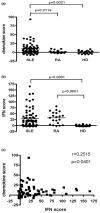Association of elevated transcript levels of interferon-inducible chemokines with disease activity and organ damage in systemic lupus erythematosus patients
- PMID: 18793417
- PMCID: PMC2592795
- DOI: 10.1186/ar2510
Association of elevated transcript levels of interferon-inducible chemokines with disease activity and organ damage in systemic lupus erythematosus patients
Abstract
Introduction: Systemic lupus erythematosus (SLE) is a multi-system autoimmune disease with a heterogeneous course and varying degrees of severity and organ damage; thus, there is increasing interest in identifying biomarkers for SLE. In this study we correlated the combined expression level of multiple interferon-inducible chemokines with disease activity, degree of organ damage and clinical features in SLE, and we investigated their roles as biomarkers.
Methods: Peripheral blood cells obtained from 67 patients with SLE patients, 20 patients with rheumatoid arthritis (RA) and 23 healthy donors were subjected to real-time PCR in order to measure the transcriptional levels of seven interferon-inducible chemokines (RANTES, MCP-1, CCL19, MIG, IP-10, CXCL11, and IL-8). The data were used to calculate a chemokine score for each participant, after which comparisons were performed between various groups of SLE patients and control individuals.
Results: Chemokine scores were significantly elevated in SLE patients versus RA patients and healthy donors (P = 0.012 and P = 0.002, respectively). Chemokine scores were correlated positively with SLE Disease Activity Index 2000 scores (P = 0.005) and negatively with C3 levels (P < 0.001). Compared with patients without lupus nephritis and those with inactive lupus nephritis, chemokine scores were elevated in patients with active lupus nephritis, especially when their daily prednisone dosage was under 30 mg (P = 0.002 and P = 0.014, respectively). Elevated chemokine scores were also associated with the presence of cumulative organ damage (Systemic Lupus International Collaborating Clinics/American Society of Rheumatology Damage Index >or= 1; P = 0.010) and the occurrence of anti-Sm or anti-RNP autoantibodies (both P = 0.021).
Conclusions: The combined transcription level of interferon-inducible chemokines in peripheral blood leucocytes is closely associated with disease activity, degree of organ damage, and specific autoantibody patterns in SLE. The chemokine score may serve as a new biomarker for active and severe disease in SLE.
Figures



References
-
- Kirou KA, Lee C, George S, Louca K, Papagiannis LG, Peterson MGE, Ly N, Woodward RN, Fry KE, Lau AYH, Prentice JG, Wohlgemuth JG, Crow MK. Coordinate overexpression of interferon-alpha-induced genes in systemic lupus erythematosus. Arthritis Rheum. 2004;50:3958–3967. doi: 10.1002/art.20798. - DOI - PubMed
-
- Baechler EC, Batliwalla FM, Karypis G, Gaffney PM, Ortmann WA, Espe KJ, Shark KB, Grande WJ, Hughes KM, Kapur V, Gregersen PK, Behrens TW. Interferon-inducible gene expression signature in peripheral blood cells of patients with severe lupus. Proc Natl Acad Sci USA. 2003;100:2610–2615. doi: 10.1073/pnas.0337679100. - DOI - PMC - PubMed
-
- Feng XB, Wu H, Grossman JM, Hanvivadhanakul P, FitzGerald JD, Park GS, Dong X, Chen WL, Kim MH, Weng HH, Furst DE, Gorn A, McMahon M, Taylor M, Brahn E, Hahn BH, Tsao BP. Association of increased interferon-inducible gene expression with disease activity and lupus nephritis in patients with systemic lupus erythematosus. Arthritis Rheum. 2006;54:2951–2962. doi: 10.1002/art.22044. - DOI - PubMed
Publication types
MeSH terms
Substances
LinkOut - more resources
Full Text Sources
Other Literature Sources
Research Materials
Miscellaneous

